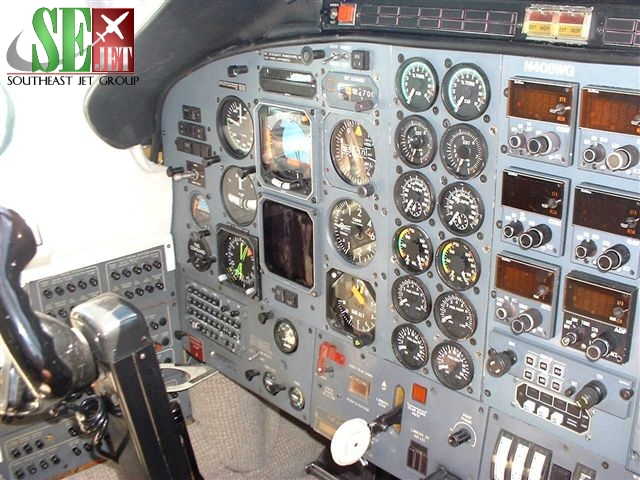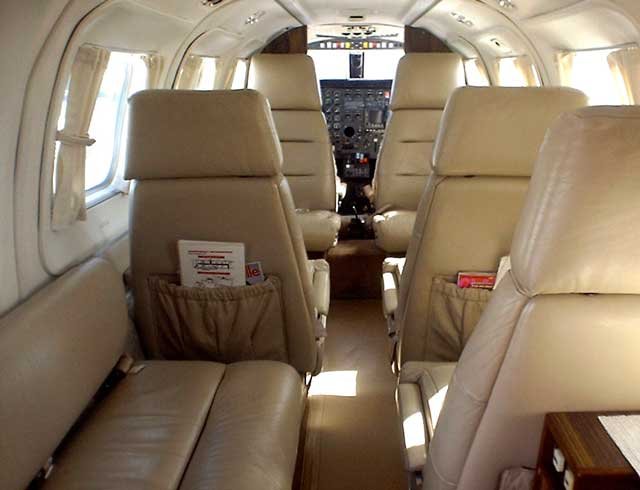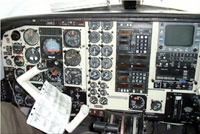
|
Piper Cheyenne 400LS
(Pa42)
|
325 KTS @ FL410 1.600
NM IN 5 HRS


| Manufacturer | Designator | Powerplant | Max. | Length | Width | Height | Max.T.O. | Empty | Max | Max. | Take-off | Service | Normal | Fuel | Max. | Max. |
| Seating | Weight | Weight | Load | Fuel | Perform. | Ceiling | Cruise | Flow | Cruise | |||||||
| P- | TPE 331-14 |
1 + 8 | (ft.) 43.4 |
(ft.) 47.7 |
(ft.) 16.6 |
(lb) 12,050 |
(lb) 7,546 |
(lb) 4,589 |
(USgals) 570 |
(ft.) 2,232 |
(ft.) 41,000 |
(kts) 326 |
(lb/hr) 563 |
(kts) 351 |
(n.m.) 1,682 |

| Horsepower: 2X1000 | Gross Weight: 12050 lbs |
| Top Speed: 351 kts | Empty Weight: 7856 lbs |
| Cruise Speed: 334 kts | Fuel Capacity: 3819.00 gal |
| Stall Speed (dirty): kts | Range: 1879 nm |
|
|
|
| Takeoff | Landing |
| Ground Roll: ft | Ground Roll ft |
| Over 50 ft obstacle: 1930 ft | Over 50 ft obstacle: 2280 ft |
|
|
|
| Rate Of Climb: 3242 fpm | Rate of Climb (One Engine): 997 fpm |
| Ceiling: 41000 ft | Ceiling (One Engine): 28700 ft |
|
|
|
 The stiff controls help to make the Cheyenne appear stable in all phases of flight but it was like trying to drive a car with the power steering switched off. Checking longitudal stability, I pushed the nose down initially with one hand and then two. With a 5 degree nose down attitude, I released the column and the nose obediently rose to the horizon and then beyond. It happily went into a 700 feet per minute climb. I didn't wait for the aeroplane to settle back to its cruise attitude, as it seemed the Cheyenne would continue to climb until it went orbital. A steep turn required a firm rearwards input on the column, but once established in the turn, the aircraft felt rock steady. Roll rate was fair. Being the sophisticated high performance aircraft that it is, the Cheyenne 400 is equipped with a stick shaker and pusher as well as a yaw damper. The flying characteristics at the stall are therefore academic as the stall is defined by the pusher forcing the nose down rather than the airflow breaking away from the wing. Better to see how the aircraft performed in the circuit. Turning for home I made an obvious mistake. I simply put the nose down. In a piston this is fine, it gets you home quickly and keeps the engines warm - but not in the Cheyenne. This is an aircraft that, thanks to its huge abundance of power, operates close to its redline Vmo speed as a matter of routine. Putting the nose down simply sent the airspeed round to the wrong side of the striped barber's pole at an indicated 270 knots indicated. I quickly pulled the power back to just 30 percent and even so we were in danger of exceeding the 250 knot speed limit drawing close to Lanseria. The gear came out at 170 knots and then I made my second mistake by underestimating the space needed to make the final approach turn. After an inadvertent hammerhead I managed to hit 130 knots before applying full flap.. This brought the speed back to 125 knots or blue line, until crossing the fence at 110 knots. Due to the heavy controls, the aircraft needs to be correctly trimmed and fortunately trim input is minor during the final approach. Pulling the power all the way back over the threshold, I needn't have worried about the highly loaded wing giving up flying suddenly. I held the nose up and waited for the Cheyenne to settle gently onto the runway. This is an aeroplane that floats thanks to its long low wing and residual thrust. Eventually the wheels touched in an almost level attitude, with the nosewheel following soon after the mains. It is recommended that once the mains have contact, the nosewheel be lowered immediately and held down to stop the aeroplane from jumping back into the sky. |
The Cheyenne 400 loves to fly. I applied power and lifted the flaps for the go-around. Backpressure on the column gave an easy rotation despite our relatively forward C of G. The aircraft needed no forward input on the column following rotation unlike most T-tailed aircraft. On the crosswind leg, I pulled the power back to avoid busting the 6,000-foot turbine altitude circuit limit. Extending the downwind leg to accommodate slower traffic, I had plenty of time to configure the aircraft for another approach and made a rather better job of the second landing. Once down, the selection of beta mode was enough to slow us down quickly but comfortably without having to use reverse. With the big engines and propellers, reverse thrust has the ability to pile all the passengers up against the crew seats. Back on the apron, we allowed the engines to idle for a few minutes to stabilise temperatures before holding the props against the beta stops and cutting the fuel supply. I was very impressed with the 400LS and we chatted with the owner for a long time about this impressive aeroplane and its capabilities. The huge power of this Piper has made this not just a hot rod special of limited utility but an aircraft of immense practical use. It is capable of taking as many people as a Citation I a far greater distance at a similar speed. The owner says that on a Lanseria to Luanda leg, the aircraft can carry more payload than a King Air 200. With 2,000lbs of fuel for four hours there is still capacity for another 2,200 lbs of passengers. Typical fuel burn at a high cruise level is 400lbs (60 US gallons) an hour - half that of a comparable Citation. With total useable fuel of 570 gallons, the aircraft can comfortably make Johannesburg to Mauritius non-stop. Even compared to the original 'bionic budgie', the Boeing 737, the Cheyenne performs well. The Boeing takes about 18 minutes at gross weight to climb to flight level 330, the Cheyenne will climb to flight level 350 in just 16 minutes! In the hands of Chuck Yeager, the Cheyenne 400 holds all the time-to-climb records in its class. A Citation II takes six minutes longer than the Cheyenne to get to flight level 350. This means the 400LS gets to cruise speeds and low fuel burn rates quicker than pure jets and very much cheaper. In conclusion, while Piper may have lost the race for pre-eminence in the construction of general aviation aircraft, they lost despite having some excellent products, despite the unlikelihood of ever seeing Piper rejoin the big business multi market again. |
|
Operating Expenses
|
|
| Fuel (gph): | 100.00 |
| Fuel Costs/Gallon: | $2.50 |
| Fuel Costs/Hour: | $250.00 |
| Oil Costs per Hour: | $.50 |
| Maintenance Cost/Hour: | $150.00 |
| Hourly Engine Reserve: | $125.00 |
| Prop Reserve: | $9.00 |
| Total Variable Costs/Hour: | $535.50 |
| Average Speed (kts): | 285 |
| Annual Insurance: | $11,500.00 |
| Annual Hangar/Tiedown: | $8,000.00 |
| Training: | $9,000.00 |
| Total Fixed Costs: | $28,500.00 |
| Hours/Year: | 200 |
| Fixed Cost/Hour: | $142.00 |
| Total Variable & Fixed Costs/Year: | $135,600.00 |
| Total Costs/Hour: | $678.00 |
|
Piper Cheyenne 400LS
|
||||
|
Performance Specifications
|
||||
|
|
||||
| Engine: |
Garrett TPE331-14
|
Range: |
1169 nm
|
|
| Horsepower: |
1000 shp
|
Service Ceiling: |
41,000 ft
|
|
| Recommended TBO: |
3000 hrs
|
Sngl Eng Srvc Ceiling: |
28,700 ft
|
|
| Wingspan: |
47.67 ft
|
75% Cruise: |
358 kts
|
|
| Length: |
43.42 ft
|
Stall: |
92 kts
|
|
| Height: |
17.00 ft
|
Rate of Climb: |
3242 ft/min
|
|
| Empty Weight: |
7478lbs
|
Sngl Eng Rate of Climb: |
997 ft/min
|
|
| Gross Weight: |
12,135 lbs
|
Takeoff (over 50' obst): |
2685 ft
|
|
| Maximum Fuel: |
570 gal
|
Landing (over 50' obst): |
3805 ft
|
|
|
|
||||